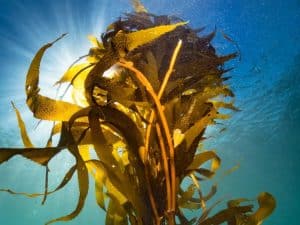 Kelp are sea creatures. They are large algae seaweeds that can grow faster than a tropical bamboo. They have more or less 30 different genera. They live in the shallow oceans or you can say in the underwater forests. They were first time discovered in the Miocene, 23 to million years ago. Kelp can grow about 3-5 inches per day and 10-20 in the bay. In under ideal conditions, giant kelp may grow up to 2 feet per day.
Kelp are sea creatures. They are large algae seaweeds that can grow faster than a tropical bamboo. They have more or less 30 different genera. They live in the shallow oceans or you can say in the underwater forests. They were first time discovered in the Miocene, 23 to million years ago. Kelp can grow about 3-5 inches per day and 10-20 in the bay. In under ideal conditions, giant kelp may grow up to 2 feet per day.
Kelp are very simple organisms. They only consist blade, hold-fast, and a stipe. At the bottom, they have a root-like shape called a hold-fast. This area will be anchored into the rocks and other materials in the sea floors. Young kelp must compete for space to settle and grow.
As the rocky bottom will be filled with the small algae and invertebrates. A stipe is similar to a plant’s stem. It is strong yet flexible allowing the kelp sway in the current ocean. Many fishes will use this area as a hidden space when they hunt for a prey. The blades contain a special gas which act like a float keeping the kelp close to the surface of the water when they absorb the energy from the sun.
Giant kelp normally grows in turbulent water. In this condition, it can bring renewed supplies of nutrients allowing these plants to grow until 175 feet. Kelp require a nutrient-rich water which has 6-14 degrees C (43 and 57 degrees F) They are famous for its high growth rate. The Macrocystis and Nereocystis even can grow half a meter per day, and they can reach around 30-80 meters. Some of them can live more than 7 years.
Read:
- Endangered Plants in The Ocean
- Types of Jellyfish
- Endangered Species in The Ocean
- List of Marine Invertebrates
Habitat
Kelp normally grows in along rocky coastlines. They can live about 2 m up to 30 m below the surface. Kelp lives in clear water conditions that have enough sunshine. Kelp will successfully grow in the area which has ocean layers overturn, nutrient-rich waters, and also cool. This particular condition normally will be found in southern California. Kelp will positively grow if they have a strong substrate. If they anchored in the strong and large rock, Kelp will successfully survive.
Kelp will attach with the sea floor and eventually will grow towards the water’s surface and relies on the sunlight when they generate food and energy. In general, kelp will live longer and further in the tropics than coral reefs, mangrove forest, and warm-water sea-grass beds. This will make kelp not overlapping its system. Kelp are the home for thousands of species in the sea such as the invertebrates, fishes, and also other algae.
Meanwhile, here we inform you about how many types of kelp live in Ocean, as follows:
1. Laminaria
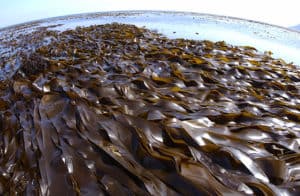 Laminaria is one of seaweed types that is native to Japan. These kelp contain iodine, an element that the body needs to make thyroid hormones. Its characteristics are long, leathery laminae and mostly have a large size.
Laminaria is one of seaweed types that is native to Japan. These kelp contain iodine, an element that the body needs to make thyroid hormones. Its characteristics are long, leathery laminae and mostly have a large size.
Even it is native to Japan, they also can be found in the Atlantic Ocean and the Northern Pacific ocean. They are sticky and thick when they contact with the water.
They live 8 to 30 m under the surface. Then, in the Mediterranean Sea and off Brazil they can grow up to 120 m because they have warmer water. Laminaria is the home for many fish and invertebrates. Laminaria mostly used as medicine, energy, food, and etc.
See Also: Ocean Seashells – Producers in Ocean Ecosystems
2. Kelp Forest
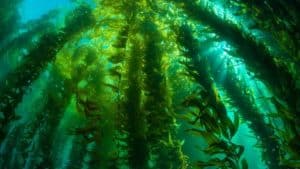 Kelp forest can be seen in along the west coast of the North America. These kelp is the most beautiful and astonishing kelp among all. They normally can be found in the shallow open coastal waters with less than 20°C in temperature. In southern California, they can grow around 30 cm per day.
Kelp forest can be seen in along the west coast of the North America. These kelp is the most beautiful and astonishing kelp among all. They normally can be found in the shallow open coastal waters with less than 20°C in temperature. In southern California, they can grow around 30 cm per day.
These underwater towers of kelp provided food and shelter for the creature for marine creatures. Many marine creatures using this as a shelter or place to hunt or even prevent them from the storm.
Kelp forest has a greater variety and diversity of plants and animals than almost any other ocean community. Then, healthy kelp forest maintains the ecosystem in the ocean such as stock of fishes, plants, and animals.
Read: Facts of Blue Whales – Endangered Blue Whales
3. Giant Kelp
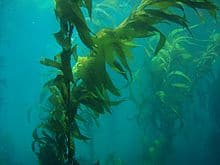
Giant kelp commonly live along the coast of the eastern Pacific Ocean. It is normally found from north Baja California to southeast Alaska, and also found in the southern oceans near South America, South Africa, Australia, and New Zealand. This area can remain below 21°C as this is the best habitat for them.
Giant kelp is the fastest kelp to growing organisms in the world. These kelp may grow up to 45 meters (150 feet) long in average which means 60 cm per day.
As we know, Giant kelp grows dense stands or we know it as kelp forests and also the home as well as foods for many ocean creatures. Humans sometimes harvest this species in a limited number as direct food. They are rich in iodine, potassium and other minerals. They normally can be used for cooking and particular bean dishes.
Read: Conservations of Dolphins – Smallest Dophins in The World
4. Winged Kelp
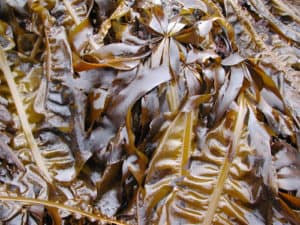
Winged kelp are really well known in Ireland. It is a common alga that grows in the coastal area that severe from the wave. They are the family of kelp or Laminariales. They can grow to a maximum length of 2 m. The whole body is brown with a distinct midrib with wavy membranous lamina more than 7 cm in both sides.
Their color may change green in the spring and turn into yellow brown in the summer. However, they have a variety color. They can be dark green or almost black. Winged Kelp normally being harvested in summer and they will be dried. Firstly, they cut into ribbons. Next, dry them in sun. Do not store them while they are still wet.
Important note to take when you want to harvest them is leaving the hold-fast intact and stipe. The stipe length should 20 cm. With this way, the winged kelp may be harvested again.
Read : Animals in The Ocean Biome – Types of Ocean Rays
5. Feather Boa Kelp
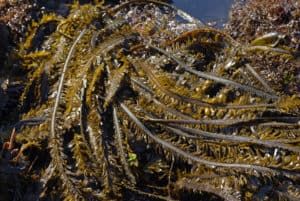
Feather Boa Kelp or Egregia menziesii is one of Kelp Species. They live in western North America from Alaska to Baja California. Feather Boa Kelp normally living in rocky areas. They have dark brown or olive in color with shiny and bumpy texture. They might grow up to 4 meters long.
They grow a branch stipe from a thick hold-fast. They grow small blades in each of few centimeters of their body. Their body contains nitrogen and phosphate more than the Giant kelp.
This kelp is a natural fertilizer. In the past, people collect this kelp off the beaches and use them as a fertilizer for their crops. Feather Boa Kelp also a source of Alginic Acid. This material mostly used in the making of detergents, cosmetics, and food products.
Read: Conservation of Tortoise – Ways to Save The Ocean
6. Kombu
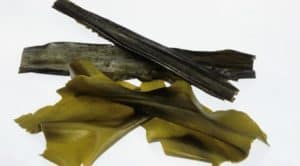 Kombu or Saccharia japnica is a native Japanese kelp that is included in the family of Laminariaceae. It’s a marine species of brown algae that is cultivated mostly in Japan and Korean, They are harvested on ropes in the sea. Kombu is a common food in East Asia.
Kombu or Saccharia japnica is a native Japanese kelp that is included in the family of Laminariaceae. It’s a marine species of brown algae that is cultivated mostly in Japan and Korean, They are harvested on ropes in the sea. Kombu is a common food in East Asia.
As we mentioned before this marine creature were grow and harvested using rope. They will use the rope to grow the kelp. In China they called this species as Haidai.
While Japanese called them as Ma-Konbu, and Korean called them as Dasima. This type of kelp is widely cultivated in China, Russia, France, Korea and Japan. China even produces more than 10 thousand tonnes of Kombu every single year. In Japan itself, 90% of Japanese are cultivating Kombu. Mostly in Hokkaido.
Kombu is a good natural source of glutamic acid. This kelp also contains a high level of iodine. In a normal dose, the mineral that contains inside their body is a good mineral for growth. But, having too much of it can cause an overdose.
Read: Facts of Whale Shark – Ways to Prevent Overfishing
7. Alaria
 Alaria is a genus of brown Algae. A member of Laminariales. They only grow around 15 cm and have around 15 m in length. Alaria mostly living in Pacific and Atlantic ocean. They are typically live in the sub-littoral area. The most important point of the growth of Alaria is the temperature. They normally can grow at 16 degrees or less. Because of the temperature factor, alaria growth is decreasing.
Alaria is a genus of brown Algae. A member of Laminariales. They only grow around 15 cm and have around 15 m in length. Alaria mostly living in Pacific and Atlantic ocean. They are typically live in the sub-littoral area. The most important point of the growth of Alaria is the temperature. They normally can grow at 16 degrees or less. Because of the temperature factor, alaria growth is decreasing.
These kelp were commonly being eaten in the Far East (China, Japan, Korea), these places are the place that has a high consumption of seaweeds.
Then, as we mentioned before, seaweed is one of the high nutrients foods, they typically have low fat but a good vitamin and minerals contains inside them. Alaria itself is an excellent and good natural source of protein and iodine.
Read: Types of Algae –Conservations of Oceans
8. Oarweed
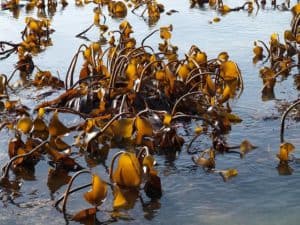 Oarweed is typically found in the sites on shores in the littoral area where it may form an extensive meadows and a dominant algae species. They have a very significant growth rate compare to the other algae, around 5,5 % per day. They may reach and grow about 4 m in length. Their distribution will be limited by their salinity, beach wave exposure, the temperature and their general stress.
Oarweed is typically found in the sites on shores in the littoral area where it may form an extensive meadows and a dominant algae species. They have a very significant growth rate compare to the other algae, around 5,5 % per day. They may reach and grow about 4 m in length. Their distribution will be limited by their salinity, beach wave exposure, the temperature and their general stress.
Oarweed mostly used as a fertilizer in the past and spread on the land. In the 19th century Oarweed was used for the extraction of iodine. However, this kind of business were died because the cheaper sources were coming.
Nowadays, Oarweed still being used as a fertilizer and also for the extraction of Alginic Acid. This alginic acid commonly being used in manufacture of cosmetics and toothpaste. In Japan and China, they still become the most favorite ingredients for making dashi, a soup stock and many culinary purposes.
See also: Ways to Protect the Marine Life – Volcano under the Ocean
9. Wakame
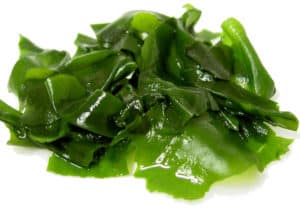
Wakame is one of edible brown seaweed and the most famous seaweed in Japan and Korea. Wakame has a high level in nutrient value, and they also have a very low calories with minimal in fat. They contains about 5 calories per serving which means this can help you to burn fat. Wakame may help you to prevent heart diseases, cancer, diabetes, and obesity.
Wakame also beneficial for the effects on stroke, high blood pressure, tumors, and inflammation. They also able to improve a good immune system.
Moreover, Wakame is a great ingredients for any diets. They provide you with nutrients and health benefits.viral infections, tumors, oxidation and inflammation while promoting a good immune system. Wakame is a great addition to any diet as there are few things we can eat that are so replete with nutrients and health benefits.
On the other hand, Wakame has Magnesium that help you in the relaxation of your muscles, giving you a production of protein. They also have Iodine that needed to have a strong metabolism of cells,. It will help you to process of converting food into energy. They also contains calcium that allows you to absorb calcium easily to your body.
Read: Conservation of Coral reef– Ocean Relief
10. Thongweed

Thongweed is a brown algae that normally grow in a lower shore of rocky shores where there is an extreme waves. They may grow up to a meter in length. When they were a little they will grow like a small button or a mushroom with only 2 cm across. By the end of the year there will be a grow emerges. Thing weed typically found in the lower zone of a rocky seashore.
Thongweed normally found in all shores with its wide tolerance for the extreme wave actions. In the early year, Thingweed will begin to grown on a shore. The button can be found on all rocky seashore.
Thongweed mostly found in Baltic sea, the North sea and the North East Atlantic ocean start from Scandinavia to Portugal. They have 30 mm wide and 25 mm high. Thongweed have two stage of morphology. Thong weed commonly live around 2-3 years and reproduce once before they finally died.
Read: Red Sea Fish Species– Facts of Dead Sea
Benefits
because of its variety of nutrients, kelp has been a good companion for Asian cultures for centuries. Nowadays, western start to get the popularity of this tree-shaped plants. As more people discover many benefits this vegetable can give, we will give you briefly several amazing benefits of kelp:
1. Lose Weight
Kelp is one of the most nutrient-rich foods that really beneficial for any diet. This vegetable also has specific fat-fighting materials inside them. According to the research of the University of Newcastle, kelp have the alginates – fibers within them that significantly reduce fat digestion and absorption.
2. Nutrients
We can deny that kelp are rich of nutrients. In each of them, they have a natural source of vitamins A, B1, B2, C, D and E, as well as minerals including zinc, iodine, magnesium, iron, potassium, copper and calcium.
3. Anti-Aging
The iodine content that every kelp has offers a lot of benefits. In the study showed that this iodine in kelp may effectively remove the free radicals – chemicals that accelerate aging in the human blood cells. Try to put some kelp mask and let us know the result.
See also: Oceans in the World – Differences Between the Ocean and the Sea
4. Avoid Cancer
Kelp cannot heal you from cancer, but it may help you to slow the growth of cancer. Kelp have fucoxanthin. This material can help cancer patients to remove drug resistance. Chemotherapy treatments is an undergoing dangerous process. Therefore, by reducing the number of harmful drugs into one’s system can help the patients treat cancer.
Kelp play an important role for the oceans. They are the foods and shelter for a thousand species of marine creatures. So, although they become commercial food products, taking kelp in a large amount is really prohibited. Kelp are not only needed for the human, but also the other creatures. Be considerate to other creatures on the planet.